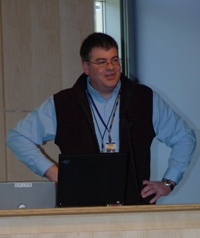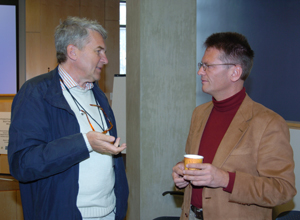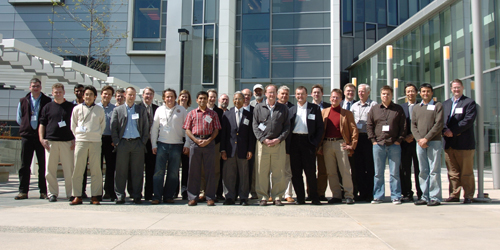'Auto Show' of a Different Kind: The Automotive Software Workshop 2006
By Maureen C. Curran
|
San Diego, CA, March 20, 2006 -- San Diego often hosts big auto shows displaying the latest concept cars of the future. A different kind of automotive gathering took place at UCSD on March 15-17, 2006: the Automotive Software Workshop 2006. The workshop was held under the auspices of Calit2, with additional sponsorship from the National Science Foundation (NSF) and the UC Discovery Grant.
There is a cyber revolution going on in the 100 year old automotive industry. "We are witnessing digital history being created around us and the automobile is an important chapter in this creation," says K. Venkatesh Prasad, the founding leader of Ford Motor Company's Infotronics Technologies Group in the Ford Research Laboratory. "The automobile is no longer steel-on-wheels but a node on a global, mobile, information grid on wheels."
The cars of today are very different internally than those of 30 years ago. When you figuratively "pop open the hood" of most modern cars there are 15 to 30 embedded computer systems, with up to 80 electronic control units in high-end models. There are over 2500 functions, thousands of dependencies, tens of controllers and up to 10 million lines of code running it all. The next generation of cars in 2007/2008 is expected to have 100 million lines of code.
"The automotive domain is in the midst of changing from an assembly industry to a systems engineering industry. The consensus in the community is that 90% of all innovations in automotive systems are directly or indirectly enabled by embedded software," says Manfred Broy, a professor of computer science at Technische Universität München (one of the workshop organizers).
"This complexity is becoming the limiting factor for automotive software development," points out Ingolf Krueger, a Calit2 research scientist, UCSD professor of computer science and engineering and a workshop organizer. In its May 2005 issue, the influential trade newsletter, "The Hansen Report On Automotive Electronics" pointed out that "while software has become an essential means to competitive advantage in the auto industry, it still has a long way to go before car makers can make use of its full potential."
With lives at stake, reliability is of utmost importance in the automotive industry. "We need to be able to leverage the advances of information and communication technologies quickly and safely," notes Broy. "In order to handle the challenges of bringing in new functionality, we need to manage the complexity. We need reliability." "The question is, how do you achieve reliability while establishing an automotive software platform that helps reduce complexity and allows OEMs and suppliers to innovate?" asks Krueger. Part of the answer lies in the theme of the workshop: "Advanced Automotive Software and Systems Development: Model-Driven Development of Reliable Automotive Services."
|
Rajesh Gupta, a computer science and engineering professor and holder of the QUALCOMM endowed chair in Embedded Microsystems at UCSD and a Calit2 affiliate, gave a keynote presentation, "Meta Modeling for Component Compositions: A Hardware Guy's View." Gupta believes that "modeling and exploitation of meta-data in design and verification are key to successful exploitation of the tremendous capabilities of distributed embedded systems. He pointed to similar developments in handling of the self-declaring data on the web and described design of a composition framework in his group that captures meta data for high-level reasoning."
Other keynote speakers included Thomas Kropf (Bosch, Germany), Jeff Greenberg (Ford Motor Company), and Bruce Emaus (Vector CANtech, USA). In his absence, the presentation of Alberto Sangiovanni-Vincentelli (UC Berkeley) was given by workshop organizer Broy. He noted that research in this area is not applicable only to the automotive domain; "it advances other similar fields, just as we learn from them."
Nearly 50 participants from around the world, including many of the leading people in this emerging field, attended the highly successful meeting. "The workshop brought together a good mix of highly ranked industrial and academic participants to exchange actual ideas and trends in automotive software engineering. Besides the lively and interesting discussions of the scientific papers, I especially enjoyed the other keynote presentations," said Thomas Kropf, the vice president of system and software engineering for 'Driver Assistance Systems' at Robert Bosch GmbH (Germany). "To provide the essence of automotive software engineering condensed into a two-and-a-half-day workshop, this was a real achievement of the organizers."
Sushil Birla, a Technical Fellow with General Motors Corporation R&D and Planning, agreed, saying "A measure of the success of the workshop was that diverse perspectives were discussed openly and candidly. Discussions over the reception dinner and afterwards were very effective in deepening mutual understanding and harmonizing the different perspectives."
In addition to five keynote speakers and two panel discussions, 13 technical papers were accepted for presentation. Massimiliano (Max) Menarini, a Calit2 researcher and first year Ph.D. student in computer science and engineering enjoyed the workshop, "It has been a wonderful experience, in just three days we got a glimpse of what lies ahead in the future of automotive software. With the mix of academia and industry attendees, we heard both exciting new research results from academia and presentations from industry that motivate the need for further research." Michael Meisinger, a Calit2 visiting scholar from Technische Universität München was the co-organizer.
Ford's Prasad was very impressed with Calit2, "The brief tour convinced me that Calit2 will go down in history as that great binding glue that holds the pages of the past together to give the future its designed form and function."
|
Related Links
Automotive Software Workshop 2006
The Hansen Report, May 2005
Automotive Workshop Image Gallery





